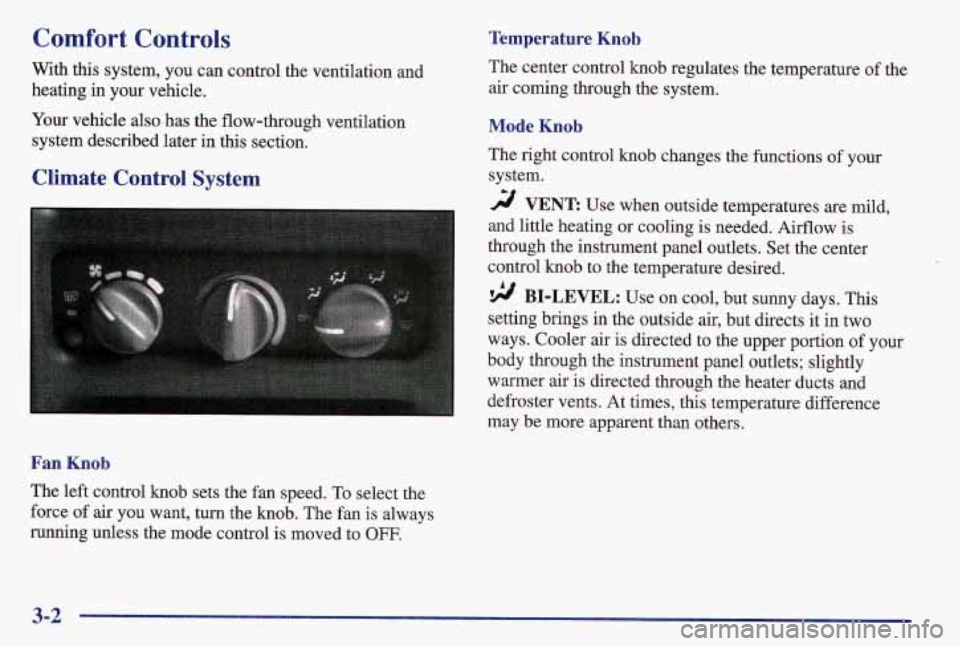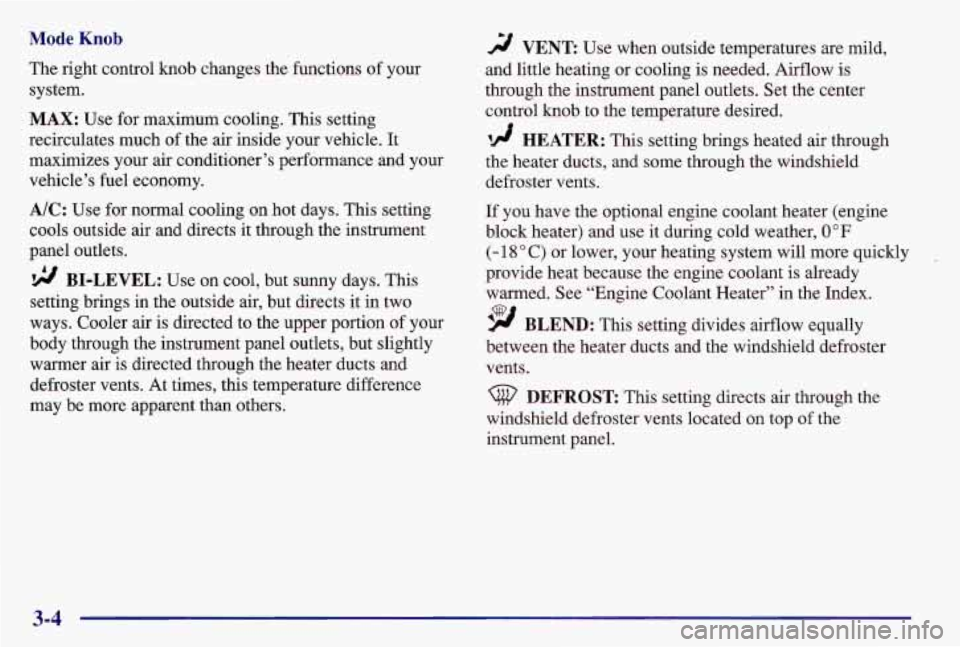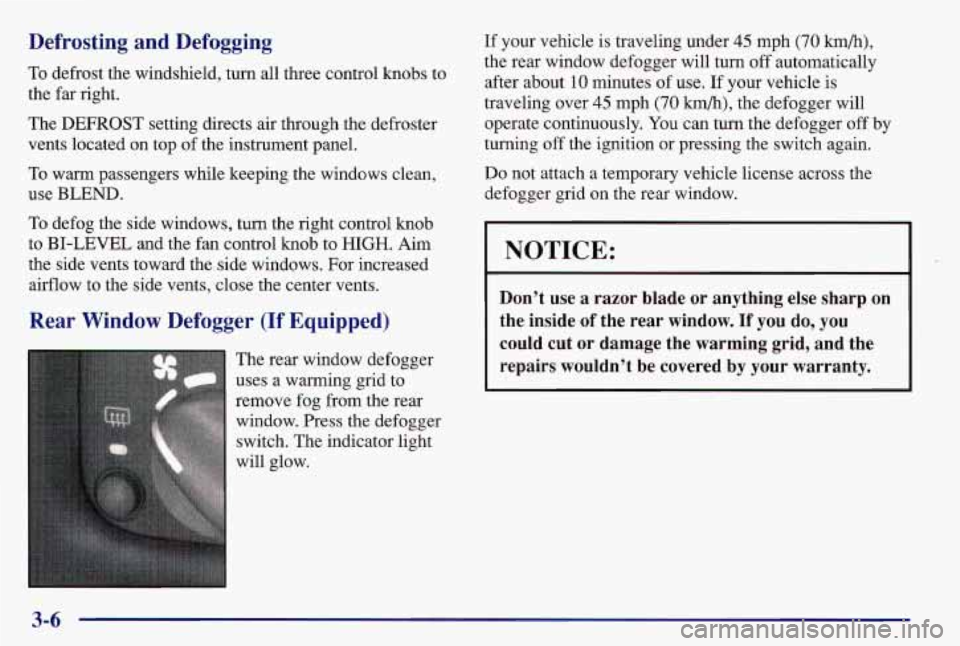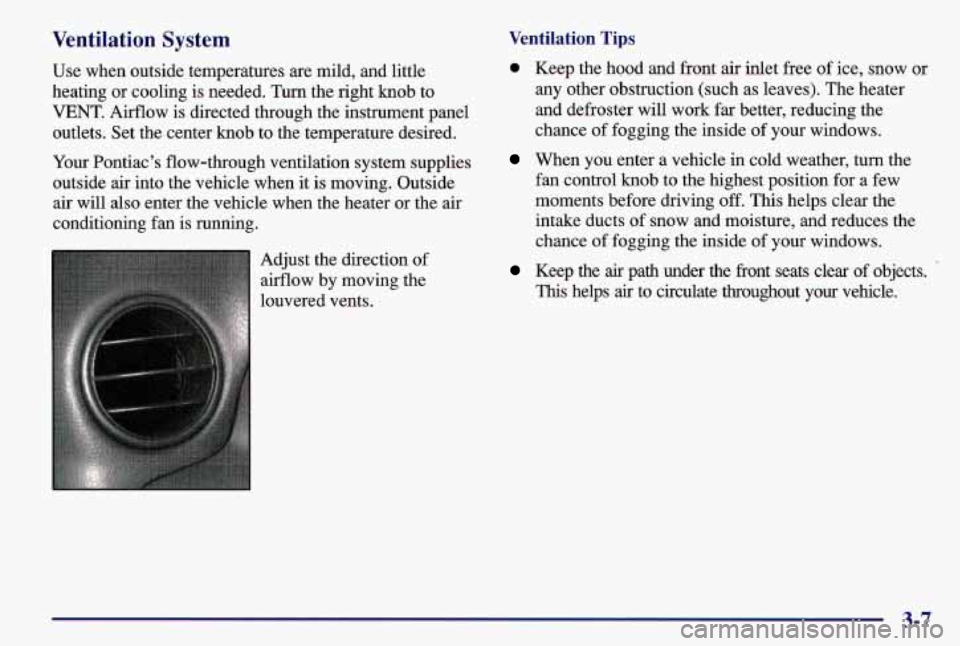Page 112 of 371
Speedometer and Odometer
Your speedometer lets you see your speed in both miles
per hour (mph) and kilometers per hour
(lun/h). Your
odometer shows how
far your vehicle has been driven,
in either miles (used in the United States) or kilometers
(used in Canada).
Your Pontiac also has a tamper-resistant odometer.
If
you see silver lines between the numbers, you’ll know
that someone has probably tried to turn
it back, so the
numbers may not be true.
You may wonder what happens
if your vehicle needs a
new odometer installed. If the new one can be set to the
mileage total of the old odometer, then it must be. But if
it can’t, then it’s set at zero and a label must be put on
the driver’s door to show the old mileage reading when
the new odometer was installed.
Trip Odometer
The trip odometer can tell you how far you have driven
since you last reset it.
To reset the trip odometer to zero,
press the knob at the top left side
of the instrument
panel cluster.
2-57
Page 114 of 371

Safety Belt Reminder Light
When the key is turned to RUN or START, a chime will
come on for about eight seconds to remind people to
fasten their safety belts, unless the driver’s safety belt is
already buckled,
The safety belt light will also come on and stay
on for about
20 seconds,
then it will flash for about
55 seconds. If the driver’s
belt is already buckled,
neither the chime nor the
light will come on.
Air Bag Readiness Light
There is an air bag readiness light on the instrument
panel, which shows AIR BAG. The system checks the
air bag’s electrical system for malfunctions. The light
tells you
if there is an electrical problem. The system
check includes the air bag sensor, the air bag modules,
the wiring and the crash sensing and diagnostic module.
For more information on the air bag system, see “Air
Bag”
in the Index.
AIR
BAG
This light will come on
when you start your engine,
and it will flash for a few
seconds. Then the light
should go out. This means
the system is ready.
If the air bag readiness light stays on after you start the -
engine or comes on when you are driving, your air bag
system may not work properly. Have your vehicle
serviced right away.
The
air bag readiness light should flash for a few
seconds when you turn the ignition key to RUN.
If the
light doesn’t come on then, have it fixed
so it will be
ready to warn you
if there is a problem.
2-59
Page 127 of 371

Comfort Controls
With this system, you can control the ventilation and
heating
in your vehicle.
Your vehicle also has the flow-through ventilation
system described later in this section.
Climate Control System
Fan Knob
The left control knob sets the fan speed. To select the
force of air you want, turn the knob. The fan is always
running unless the mode control is moved to
OFF.
Temperature Knob
The center control knob regulates the temperature of the
air coming through the system.
Mode Knob
The right control knob changes the functions of your
system.
2 VENT Use when outside temperatures are mild,
and little heating or cooling is needed. Airflow is
through the instrument panel outlets. Set the center
control knob to the temperature desired.
9 BI-LEVEL: Use on cool, but sunny days. This
setting brings in the outside air, but directs
it in two
ways. Cooler air
is directed to the upper portion of your
body through the instrument panel outlets; slightly
warmer air is directed through the heater ducts and
defroster vents. At times, this temperature difference
may be more apparent than others.
3-2
Page 128 of 371
d HEATER: This setting brings heated air through
the heater ducts, and
some through the windshield
defroster vents.
If you have the optional engine coolant heater (engine
block heater) and use it during cold weather,
0°F
(- 18°C) or lower, your heating system will more quickly
provide heat because the engine coolant is already
warmed. See “Engine Coolant Heater” in the Index.
9 BLEND: This setting divides airflow equally
between the heater ducts and the windshield defroster
vents.
DEFROST This setting directs air through the
windshield defroster vents located on top
of the
instrument panel.
Climate Control System with
Air Conditioning
Fan Knob
The left control knob sets the fan speed. To select the
force of air
you want, turn the knob. The fan is always
running unless the mode control is moved
to OFF.
Temperature Knob
The center control knob regulates the temperature of the
air coming through the system.
3-3
Page 129 of 371

Mode Knob
The right control knob changes the functions of your
system.
MAX: Use for maximum cooling. This setting
recirculates much of the air inside your vehicle. It
maximizes your air conditioner’s performance and your
vehicle’s fuel economy.
A/C: Use for normal cooling on hot days. This setting
cools outside air and directs it through the instrument
panel outlets.
9 BI-LEVEL: Use on cool, but sunny days. This
setting brings in the outside air, but directs it in two
ways. Cooler air is directed to the upper portion
of your
body through the instrument panel outlets, but slightly
warmer air is directed through the heater ducts and
defroster vents. At times, this temperature difference
may be more apparent than others.
2 VENT Use when outside temperatures are mild,
and little heating or cooling is needed. Airflow is
through the instrument panel outlets. Set the center
control knob to the temperature desired.
‘!A HEATER: This setting brings heated air through
the heater ducts, and some through the windshield
defroster vents.
If you have the optional engine coolant heater (engine
block heater) and use it during cold weather,
0°F
(- 18 O C) or lower, your heating system will more quickly
provide heat because the engine coolant is already
warmed. See “Engine Coolant Heater” in the Index.
9 BLEND: This setting divides airflow equally
between the heater ducts and the windshield defroster
vents.
DEFROST This setting directs air through the
windshield defroster vents located on top of the
instrument panel.
3-4
Page 131 of 371

Defrosting and Defogging
To defrost the windshield, turn all three control knobs to
the far right.
The DEFROST setting directs air through the defroster
vents located on top
of the instrument panel.
To warm passengers while keeping the windows clean,
use BLEND.
To defog the side windows, turn the right control knob
to BI-LEVEL and the fan control
knob to HIGH. Aim
the side vents toward the side windows. For increased
aifflow to the side vents, close the center vents.
Rear Window Defogger (If Equipped)
The rear window defogger
uses
a warming grid to
remove fog from the rear
window. Press the defogger
switch. The indicator light
will glow.
If your vehicle is traveling under 45 rnph (70 km/h),
the rear window defogger will turn off automatically
after about
10 minutes of use. If your vehicle is
traveling over
45 mph (70 km/h), the defogger will
operate continuously.
You can turn the defogger off by
turning off the ignition or pressing the switch again.
Do not attach a temporary vehicle license across the defogger grid on the rear window.
I NOTICE:
Don’t use a razor blade or anything else sharp on
the inside
of the rear window. If you do, you
could cut
or damage the warming grid, and the
repairs wouldn’t be covered by your warranty.
3-6
Page 132 of 371

Ventilation System
Use when outside temperatures are mild, and little
heating or cooling
is needed. Turn the right knob to
VENT. Airflow is directed through the instrument panel
outlets. Set the center knob to the temperature desired.
Your Pontiac’s flow-through ventilation system supplies
outside air into the vehicle when it is moving. Outside
air will also enter the vehicle when the heater or the air
conditioning fan is running.
Adjust the direction
of
airflow by moving the
louvered vents.
Ventilation Tips
0 Keep the hood and front air inlet free of ice, snow or
any other obstruction (such as leaves). The heater
and defroster will work far better, reducing the
chance of fogging the inside
of your windows.
When you enter a vehicle in cold weather, turn the
fan control knob to the highest position for a few
moments before driving
off. This helps clear the
intake ducts
of snow and moisture, and reduces the
chance
of fogging the inside of your windows.
Keep the air path under the front seats clear of objects.
This helps air to circulate throughout your vehicle.
3-7
Page 182 of 371
Follow these steps:
1. Put the front wheels on a dolly.
NOTICE:
Do not tow your vehicle with the front wheels in
contact with the
ground, or the automatic
transaxle could be damaged.
2.
3.
4.
5.
6.
Set the parking brake.
Open the fuse panel on the driver’s side of the
instrument panel. Remove the fuse labeled
PRNDL.
This will keep your battery from draining
while towing.
Turn the ignition key to
OFF to unlock the steering
wheel. See “Ignition Positions” in the Index.
Clamp the steering wheel
in a straight-ahead position,
with a clamping device designed for towing.
Release the parking brake.
Towing Your Vehicle from the Front
(Manual Transaxle Only)
If your vehicle has a manual transaxle, you may tow
your vehicle with all four wheels on the ground.
4-31